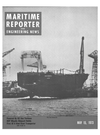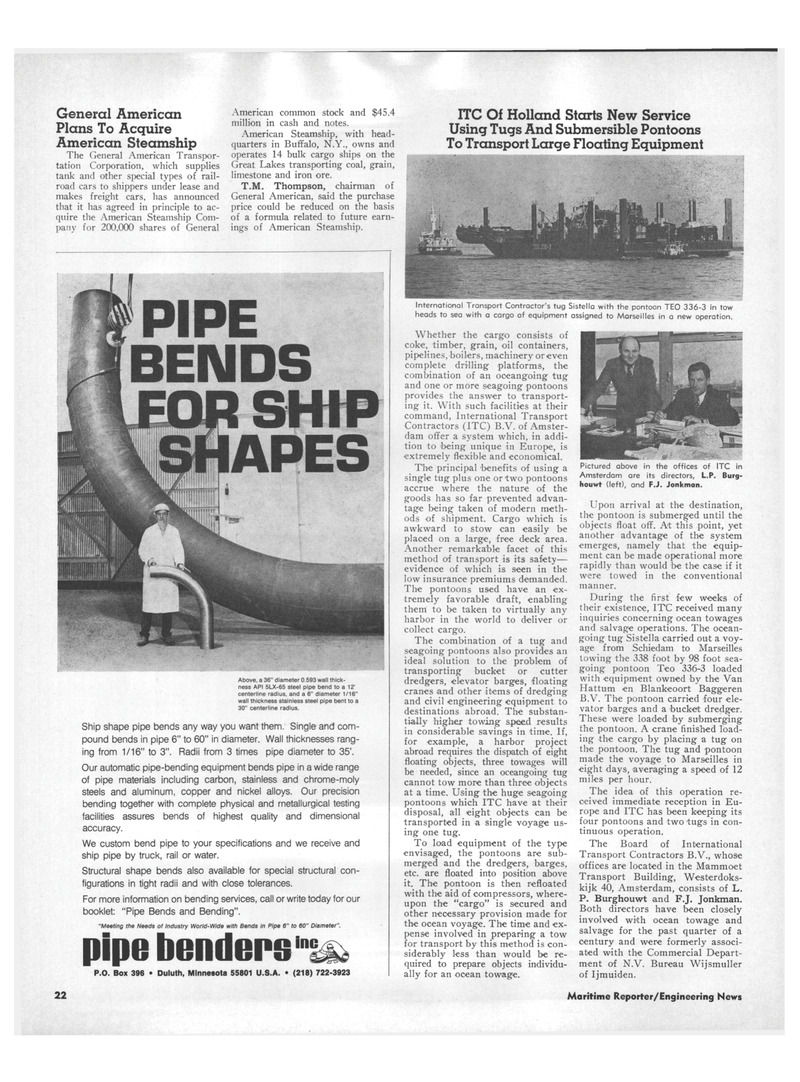
Page 20: of Maritime Reporter Magazine (May 15, 1973)
Read this page in Pdf, Flash or Html5 edition of May 15, 1973 Maritime Reporter Magazine
General American
Plans To Acquire
American Steamship
The General American Transpor- tation Corporation, which supplies tank and other special types of rail- road cars to shippers under lease and makes freight cars, has announced that it has agreed in principle to ac- quire the American Steamship Com- pany for 200,000 shares of General
American common stock and $45.4 million in cash and notes.
American Steamship, with head- quarters in Buffalo, N.Y., owns and operates 14 bulk cargo ships on the
Great Lakes transporting coal, grain, limestone and iron ore.
T.M. Thompson, chairman of
General American, said the purchase price could be reduced on the basis of a formula related to future earn- ings of American Steamship.
ITC Of Holland Starts New Service
Using Tugs And Submersible Pontoons
To Transport Large Floating Equipment
Above, a 36" diameter 0.593 wall thick- ness API 5LX-65 steel pipe bend to a 12' centerline radius, and a 6" diameter 1/16" wall thickness stainless steel pipe bent to a 30" centertine radius.
Ship shape pipe bends any way you want them. Single and com- pound bends in pipe 6" to 60" in diameter. Wall thicknesses rang- ing from 1/16" to 3". Radii from 3 times pipe diameter to 35'.
Our automatic pipe-bending equipment bends pipe in a wide range of pipe materials including carbon, stainless and chrome-moly steels and aluminum, copper and nickel alloys. Our precision bending together with complete physical and metallurgical testing facilities assures bends of highest quality and dimensional accuracy.
We custom bend pipe to your specifications and we receive and ship pipe by truck, rail or water.
Structural shape bends also available for special structural con- figurations in tight radii and with close tolerances.
For more information on bending services, call or write today for our booklet: "Pipe Bends and Bending". "Meeting the Needs ot Industry World-Wide with Bends in Pipe 6" to 60" Diameter". inc pipe benders
P.O. Box 396 • Duluth, Minnesota 55801 U.S.A. • (218) 722-3923
International Transport Contractor's tug Sistella with the pontoon TEO 336-3 in tow heads to sea with a cargo of equipment assigned to Marseilles in a new operation.
Whether the cargo consists of coke, timber, grain, oil containers, pipelines, boilers, machinery or even complete drilling platforms, the combination of an oceangoing tug and one or more seagoing pontoons provides the answer to transport- ing it. With such facilities at their command, International Transport
Contractors (ITC) B.V. of Amster- dam offer a system which, in addi- tion to being unique in Europe, is extremely flexible and economical.
The principal benefits of using a single tug plus one or two pontoons accrue where the nature of the goods has so far prevented advan- tage being taken of modern meth- ods of shipment. Cargo which is awkward to stow can easily be placed on a large, free deck area.
Another remarkable facet of this method of transport is its safety— evidence of which is seen in the low insurance premiums demanded.
The pontoons used have an ex- tremely favorable draft, enabling them to be taken to virtually any harbor in the world to deliver or collect cargo.
The combination of a tug and seagoing pontoons also provides an ideal solution to the problem of transporting bucket or cutter dredgers, elevator barges, floating cranes and other items of dredging and civil engineering equipment to destinations abroad. The substan- tially higher towing speed results in considerable savings in time. If, for example, a harbor project abroad requires the dispatch of eight floating objects, three towages will be needed, since an oceangoing tug cannot tow more than three objects at a time. Using the huge seagoing pontoons which ITC have at their disposal, all eight objects can be transported in a single voyage us- ing one tug.
To load equipment of the type envisaged, the pontoons are sub- merged and the dredgers, barges, etc. are floated into position above it. The pontoon is then refloated with the aid of compressors, where- upon the "cargo" is secured and other necessary provision made for the ocean voyage. The time and ex- pense involved in preparing a tow for transport by this method is con- siderably less than would be re- quired to prepare objects individu- ally for an ocean towage.
Pictured above in the offices of ITC in
Amsterdam are its directors, L.P. Burg- houwt (left), and F.J. Jonkman.
Upon arrival at the destination, the pontoon is submerged until the objects float off. At this point, yet another advantage of the system emerges, namely that the equip- ment can be made operational more rapidly than would be the case if it were towed in the conventional manner.
During the first few weeks of their existence, ITC received many inquiries concerning ocean towages and salvage operations. The ocean- going tug Sistella carried out a voy- age from Schiedam to Marseilles towing the 338 foot by 98 foot sea- going pontoon Teo 336-3 loaded with equipment owned by the Van
Hattum en Blankeoort Baggeren
B.V. The pontoon carried four ele- vator barges and a bucket dredger.
These were loaded by submerging the pontoon. A crane finished load- ing the cargo by placing a tug on the pontoon. The tug and pontoon made the voyage to Marseilles in eight days, averaging a speed of 12 miles per hour.
The idea of this operation re- ceived immediate reception in Eu- rope and ITC has been keeping its four pontoons and two tugs in con- tinuous operation,
The Board of International
Transport Contractors B.V., whose offices are located in the Mammoet
Transport Building, Westerdoks- kijk 40, Amsterdam, consists of L.
P. Burghouwt and F.J. Jonkman.
Both directors have been closely involved wi'th ocean towage and salvage for the past quarter of a century and were formerly associ- ated with the Commercial Depart- ment of N.V. Bureau Wijsmuller of Ijmuiden. 22 Maritime Reporter/Engineering News

 19
19

 21
21
